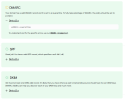thecomputerguy
Well-Known Member
- Reaction score
- 1,399
Client uses construction software called RedTeam that uses SendGrid to send email out of their system. They have always had inconsistencies in delivery when trying to send out of RedTeam. Upon contacting support at RedTeam they simply just said to set your SPF record to these settings. We've been battling them for more support for months.
The problem is ... this SPF record is already in place and has been in place since they started using the software and they've ALWAYS had delivery issues.
When sending to other Office 365 tenants they are receiving this:
Here is the SPF Record:
The problem is ... this SPF record is already in place and has been in place since they started using the software and they've ALWAYS had delivery issues.
When sending to other Office 365 tenants they are receiving this:
550 5.4.1 Recipient address rejected: Access denied
Here is the SPF Record:
v=spf1 a mx ip4:168.245.113.179 ip4:168.245.125.157 include:spf.protection.outlook.com include:sendgrid.net ~all

